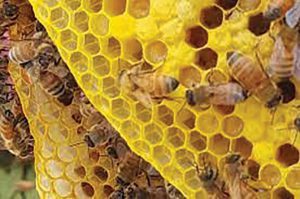 Comb Construction and Cell Capping
Comb Construction and Cell Capping
Clarence Collison
Significant Chemical And Physical Changes Occur In The Wax During Comb Building
“Wax secretion is age-related, varies with season, is unaffected by the queen, juvenile hormone or the corpora allata but is enhanced in swarming. Comb building is enhanced by the queen. Nest structure can be explained as a self-organization process as can the patterns of brood, honey and pollen. The comb and its contents provide gross information to the colony as to crowding and space which affect brood rearing, energy consumption and comb building. Significant chemical and physical changes occur in the wax during comb building and during its subsequent use. Comb mediates pheromonal cues for cell capping, repairs and queen cell construction, nectar forage, colony defense and colony odor. Mechanically, the combs transmit vibrational signals in the waggle dance and recruitment of new foragers (Hepburn 1998).”
“Ledoux et al. (2001) examined the influence of the queen and her pheromonal signal on comb construction. They tested four treatments with newly hived packages of bees containing: 1) a mated queen, 2) a virgin queen, 3) no queen but with a dispenser containing synthetic queen mandibular pheromone (QMP), and 4) no queen and no pheromone. After 10 days, the comb produced by each colony was removed, comb measurements made, bees from the comb-building area collected, the size of the scales on the wax mirrors of the collected bees ranked on a scale of 0-4 and the queens removed and analyzed for QMP components. Queenless workers built substantially less comb and the comb they did build had significantly larger, drone-sized cells than for the other three treatments, indicating that both cell size and the quantity of comb built are mediated through the queen, particularly QMP. The observations of wax scale size suggested that QMP influenced comb building behavior rather than wax scale production. These results support the idea that queenless honey bees can adopt a strategy of constructing drone-sized cells in order to increase reproductive fitness through male production following queen loss.”
“Colonies of honey bees initiate new comb construction only when two conditions are met: 1) they are currently collecting nectar and 2) they have filled their available comb beyond a threshold level with brood and food. Pratt (1998a) explored how the individual workers responsible for building might use readily accessible local cues to acquire this global information on colony and environmental state. In particular, he tested the hypothesis that comb is built by nectar receivers (bees specialized to receive nectar from foragers and store it in comb cells) that experience increased distension of their crops (honey stomachs). Crop distension could serve as a cue that both conditions for building have been satisfied, because the bees’ crops will fill up as they receive nectar from successful foragers and have difficulty finding comb in which to store it. However, two findings led to rejection of this hypothesis. First, very few nectar receivers participated in comb building. Most builders came from another, unidentified subpopulation of workers. Second, potential builders showed no increase in crop size correlated with the onset of new comb construction or with the development of conditions that favor comb building. This was true both for identified nectar receiver bees and for bees belonging to the age cohort at which wax secretion and comb building reach their peak levels. The behavioral repertoire of comb-building bees suggests that these builders come from a pool of underemployed bees that may evaluate colony state by direct inspection of comb cells.”
“Wax used for comb building can be found in two forms between the worker’s mandibles: firstly, as transparent wax scales, and secondly, as a non-transparent string-like form that is created from existing wax within the colony. Siefert et al. (2021) observed the latter was predominantly seen on urgent occasions, such as quickly fixing the combs to the adjacent glass in the aperture shortly after the setup of colonies. However, the use of wax strings can often be observed later in the colony’s development. Since the remodeling of combs includes individuals with undeveloped wax glands, it enables quick shifts in division of labor. To create a string of wax, the worker moves its head quickly back and forth, similar to a pecking bird, while the string between the mandibles is extended. The wax strings can be several millimeters in length and are extended below the head and thorax. Long strings are folded for transportation using the prothoracic legs and the mandibles.To retrieve a wax scale from the intersternal pockets, the worker uses the basitarsal brushes of the hind leg. Retrieving the scale from the pocket takes about five seconds. The subsequent transportation of the scales to the mouthparts with the same leg takes just 400 milliseconds. The use of wax scales and wax strings for building is the reverse of the process of wax string extension described above, including the rapid head and mandible movements.”

“After the main flow, 12 Italian and 12 Caucasian colonies of honey bees were fed, and used to build combs from wax foundation. During a four-day period the most important factor in determining the number of combs built was the weight of the bees in the colony; the relationship was linear. Mean-maximum and mean-minimum temperatures also had an effect. During an eight-day period, colonies weighing six or seven kg (13.2-15.4 lbs.) built the most combs. Fewest were built at 20°C (68°F) mean-maximum temperature with any size of colony. Less sugar was consumed as the mean- maximum and mean-minimum temperatures increased. With small colonies, the sugar consumption increased with increasing mean-maximum temperatures, but with larger colonies it decreased. Sugar consumption per comb built depended on colony size, and on temperatures, in a rather complex way. The lowest sugar consumption per comb built was with colonies weighing 4 to 8 kg, (8.8 to 17.6 lbs.) depending on the mean-maximum temperature (Szabo 1977).”
“Upon entering a new home site a honey bee swarm is faced with the task of organizing the building activities of thousands of component bees so that several straight and parallel vertically oriented combs can be quickly and efficiently built. As a part of this organization process it is necessary for the bees to select and agree upon a planar orientation for the new combs. De Jong (1982) presents evidence that memory of a previously used comb direction influences the building of the new set of combs. Swarms which have recently moved into bait-hives (empty boxes placed in trees to attract feral swarms) tend to maintain the previously used comb direction when removed and forced to build new combs, whereas swarms which have occupied the bait-hives for a longer period (over 9 days) do not. Recent swarms predictably alter their comb building direction within the influence of an applied earth strength magnetic field, indicating that honey bees are able to use the earth’s magnetic field as a reference at the commencement of comb construction in a new hive.”
“Honey bees have long been assumed to build their comb with the cells in either of two preferred orientations with respect to gravity (“vertical” or “horizontal). Pratt (2000) showed that these typical cell orientations are derived from substrate orientation and a simple building rule, rather than the influence of gravity itself. When bees were induced to build comb on substrates at four different orientations with respect to gravity, they always made cells with one vertex pointing directly toward the substrate. This produced horizontal and vertical cells on vertical and horizontal substrates, respectively, but yielded intermediate orientations on oblique substrates. The apparent preference for vertical and horizontal cells may simply reflect substrate orientation in the rectilinear hives from which cell measurements have been taken.”
“Honey bee colonies furnish their nests with two types of comb distinguished by cell size: large cells for rearing males (drone comb) and small cells for rearing workers (worker comb). The bees actively regulate the relative quantity of each type, a behavior likely to be important in setting a colony’s sex ratio. Experimental analysis of the information pathways and control mechanisms responsible for this regulation found the following results. The amount of drone comb in a nest is governed by negative feedback from drone comb already constructed. This feedback depends on the workers having direct contact with the drone comb in their nest, but does not depend on the queen’s contact with the comb. The comb itself, rather than the brood within it, is sufficient to provide the negative feedback, although the brood may also contribute to the effect. These findings show that drone comb regulation does not depend on the queen acting as a centralized information gatherer and behavioral controller. Instead, the evidence points to a decision-making process distributed across the population of worker bees, a control architecture typical of colony organization in honey bees and other large colony insect societies (Pratt 1998b).”
“In comb building several festoons may begin building at independent sites. Combs are made parallel by manipulating the length of cells but dislocated combs are incorporated into the total nest structure. Parallelism is achieved through passive application of the bee space. Cell size and orientation vary independently and are unique to each festoon and comb. Combs are joined laterally near their mid-sections. Cells are approximately hexagonal within a comb, but poor fit requires the insertion of pentagons, heptagons, and the use of fill and vacancies for the fusion of small combs into a single large comb (Hepburn and Whiffler 1991).”
“The actual construction of comb is performed by older workers, at ages averaging only a few days older than those for brood-tending bees. A typical comb builder might spend some of her time in a comb-building cluster, then move to the brood area and inspect or feed larvae and perhaps do other cleaning or food handling chores before returning to comb building. This alternation of tasks provides time for the wax glands to produce more wax for construction, and for the hypopharyngeal and mandibular glands to produce brood food (Winston 1987).”
“When construction begins, the workers hang together in tight chains, forming a dense cluster in which they maintain a temperature of 35°C (95°F), the best temperature for wax secretion and manipulation. Flakes of wax are removed by the enlarged first tarsal joint of the hind leg from four paired glands on the underside of the abdomen and passed forward for construction and manipulations by the front legs and mandibles. The wax is mixed with saliva and kneaded to the proper consistency and degree of plasticity at which it can best be molded (Winston 1987).”
“Construction progresses in a seemingly random fashion, since several bees contribute to the building of any one cell, and several cells are under construction simultaneously. Workers begin construction on the roof or side of the nest cavity, with perhaps two or three construction sites initially for each comb. Thick layers of wax are first placed at the base of what will be each comb, and these are gradually drawn out into cells by elongating and thinning the wax into the cell walls. A single worker may add wax or smooth it, moving from cell to cell and building site to building site in no evident order. Apparently, each worker can perceive the stage of construction at each new location and contributes whatever is needed for that cell. As a result of this series of individual actions, each section of comb is linked with the others so that no traces of their separate beginnings are visible. The precision and strength of the newly built comb is remarkable (Winston 1987).”
“The construction period of a worker’s life usually has two stages, cell capping by young workers and comb construction by older workers. The early capping behavior is possible since workers as young as two or three days old can produce wax, although the glands are most highly developed in workers eight-17 days old. Also, older wax-producing workers place wax scales on the rims of cells which need to be capped, so that copious wax production by the younger cappers is not necessary and workers can shape and manipulate wax whether or not they are secreting wax themselves. Capping is somewhat unorganized process in which many workers each do a small bit of capping construction in an unsystematic fashion. A typical cell might take over six hours to cap and have hundreds of workers participating in capping construction. Not all workers help to complete the task; often a worker will remove a piece of wax from one partially capped cell and add it to an adjoining cell capping (Winston 1987).”
“Shortly before metamorphosis the honey bee larva turns around in its comb cell and spins its cocoon. At this time the cell opening must already be closed by a capping made of bee’s wax, otherwise the larva will fall out and die. Recently Le Conte et al. (1990) reported the isolation and identification of a mixture of pheromones (aliphatic fatty esters) that could induce capping behavior. Trouiller et al. (1991) have analyzed the temporal secretion of several fatty esters and conclude that the role of the above-mentioned esters as pheromone “is now supported by evidence that these compounds are present in the cuticle only a few hours before the cell is capped.” Goetz and Koeniger (1992) examined the effect on capping behavior of the distance between the larva and the cell opening. Shortened brood cells (with reduced depth) were capped earlier than normal cells. After capping, larval weight in shortened cells was lower than in control cells. Larvae of elongated cells were heavier than control larvae after capping. These results indicate that mechanical stimuli play an important role in triggering capping of cells.”
“In honey bees, methyl palmitate (MP), methyl oleate (MO), methyl linoleate (ML), and methyl linolenate (MLN) are important pheromone components of the capping pheromones triggering the capping behavior of worker bees. Quin et al. (2019) compared the amounts of these four pheromone components in the larvae of workers and drones, prior to being capped, in the process of being capped and had been capped. The amounts of MP, MO, and MLN peaked at the capping larval stage, and ML was highest at capped larvae in worker larvae, whereas in drone larvae, the amounts of the four pheromone components were higher overall and increased with aging. Furthermore, they proposed de novo biosynthetic pathways for MP, MO, ML and MLN, from acetyl-CoA. Besides, stable isotope tracer 13C and deuterium were used to confirm that these capping pheromone components were de novo synthesized by larvae themselves rather than from their diets.”
“When larvae reach the stage of pupation, their cells are closed off by workers constructing a thin wax cap over the cell so that the larvae pupate in a clean and stable environment. Four components of BEP are particularly important in triggering the capping behavior of workers (Qin et al. 2019).”
“During building activity, workers move frequently within the cell, either back and forth or in longitudinal turns. Furthermore, frequent antennal and head movement is present. During cell capping, the worker frequently inserts its antennae into the closing hole of the cell as it is capped and puts its front tarsi onto the extended rim. They presume that the worker does so to measure the thickness of the cap. Capping is carefully adjusted to the larva’s developmental state, and cocooning starts before the cell is completely closed (Siefert et al. 2021).”
References
De Jong, D. 1982. Orientation of comb building by honeybees. J. Comp. Physiol. 147: 495-501.
Goetz, B. and N. Koeniger 1992. Structural features trigger capping of brood cells in honey bees. Apidologie 23: 211-216.
Hepburn, H.R. 1998. Reciprocal interactions between honeybees and combs in the integration of some colony functions in Apis mellifera L. Apidologie 29: 47-66.
Hepburn, H.R. and L.A. Whiffler 1991. Construction defects define pattern and method in comb building by honeybees. Apidologie 22: 381-388.
Le Conte, Y., G. Arnold, J. Trouiller, C. Masson and B. Chappe 1990. Identification of a brood pheromone in honey bees. Naturwissenschaften 77: 334-336.
Ledoux, M.N., M.L. Winston, H. Higo, C.I. Keeling, K.N. Slessor and Y. Le Conte 2001. Queen and pheromonal factors influencing comb construction by simulated honey bee (Apis mellifera L.) swarms. Insectes Soc. 48: 14-20.
Pratt, S.C. 1998a. Condition-dependent timing of comb construction by honeybee colonies: how do workers know when to start building? Anim. Behav. 56: 603-610.
Pratt, S.C. 1998b. Decentralized control of drone comb construction in honey bee colonies. Behav. Ecol. Sociobiol. 42: 193-205.
Pratt, S.C. 2000. Gravity-independent orientation of honeycomb cells. Naturwissenschaften 87: 33-35.
Qin, Q.-H., X.-J. He, A.B. Barron, L. Guo, W.-J. Jiang and Z.-J. Zeng 2019. The capping pheromones and putative biosynthetic pathways in worker and drone larvae of honey bees Apis mellifera. Apidologie 50: 793-803.
Siefert, P., N. Buling, and B. Grünewald 2021. Honey bee behaviour within the hive: insights from long-term video analysis. PLoS ONE 16(3): e0247323
Szabo, T.I. 1977. Effect of colony size and ambient temperature on comb building and sugar consumption by honeybees. J. Apic. Res. 16: 174-183.
Trouiller, J., G. Arnold, Y. Le Conte and C. Masson 1991. Temporal pheromonal and kairomonal secretion in the brood of honey bees. Naturwissenschaften 78: 368- 370.
Winston, M.L. 1987. The Biology Of The Honey Bee. Harvard University Press, Cambridge, MA, 281 pp.
Clarence Collison is an Emeritus Professor of Entomology and Department Head Emeritus of Entomology and Plant Pathology at Mississippi State University, Mississippi State, MS.










